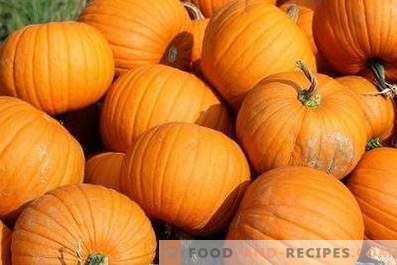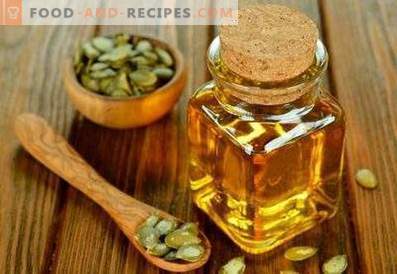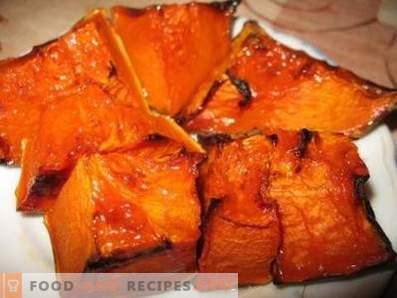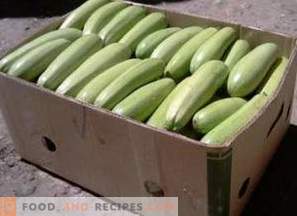
Many people buy pumpkin mainly for manta. But you can make a lot of other dishes from it: salads, soups, casseroles, puddings, cereals, pancakes and even juice.
Of course, the pumpkin variety is also important, because it can be very sweet and juicy, as well as fodder.
Pumpkin is very useful and is used not only for cooking, but also for medicinal purposes.
Useful properties of pumpkin
- There are vitamins C, B1, B2, PP in the pumpkin. She, like all orange fruits, is rich in vitamin A. For example, in pumpkin varieties Vitamin carotene 16 mg per 100 g.
- It is rich in sugars. In a sweet variety Giant up to 12 mg of sugar per 100 g.
- Pumpkin is used for kidney disease, as it has a diuretic effect.
- It is rich in trace elements such as iron, calcium, copper, potassium, cobalt and magnesium. It contains many salts of phosphoric acid, due to which the metabolism in the human body occurs.
- Pumpkin is recommended to be consumed by a sick person with tuberculosis, because there is a substance in it that has a destructive effect on the tubercle bacillus.
- Pumpkin seeds are an excellent antihelminthic.
- Pumpkin juice helps with edema. They drink it for heart disease.
- Pumpkin is well absorbed by the body, so it is included in the children's menu and is used for dietary nutrition.
- Thanks to its thick skin, the pumpkin is well kept, therefore it is stored for future use.
Which pumpkin is best to store?
There are many varieties of pumpkins. All of them differ from each other not only in shape, size, taste, but also in their ability to maintain their nutritional quality for several months after they are separated from the stem.
Most often used table pumpkin. It is very large, so it is called large-fruited. It has a thick skin, which can be either monochromatic or with a predominance of stripes. Large pumpkins include Almond, Mammoth, Stountovaya, Biryuchekutskaya 735, Mozoleevskaya, Gribovskaya winter. They have a fleshy orange flesh that is very tasty. These pumpkins are well kept, so they are most often intended for winter use.
Pumpkin varieties are stored worse, but they are much tastier. Especially prized nutmeg, which grows mainly in the Caucasus and Central Asia. Such varieties include small-fruited: White Honey, Muscat, Chalmoid, Polumalmovidnaya. If small pumpkins are sent to storage, they are tried to be used first.
Hard winter varieties can be stored for 6-8 months. And many of them ripen during storage. But fodder varieties are stored poorly.
When to pick up a pumpkin
The harvest of pumpkins begins at the end of summer and lasts until mid or late September.
Pumpkin, which is left on the beds for ripening, try to isolate from contact with the land, so that it is not damaged by slugs or rot. To do this, under the fruit put cardboard, boards, plywood or a layer of mulch. Pumpkins, intended for storage, are kept on the beds as long as possible. But before the most frosts clean.
- For harvesting choose dry and sunny weather.
- Ripe pumpkin covered with hard hornlike skin is plucked from the lash along with the stem, which should be no shorter than 4-5 cm.
- Before being sent for storage, the fruits during the day are left to lie in the sun so that they should dry properly.
- Then they are carefully inspected so that there are no dents on the skin. Check the fruit tails. If the pumpkin does not have a stalk, then such a fruit cannot be stored. After all, the pumpkin is the weakest point here, and under adverse conditions it begins to rot from here.
How the pumpkin is stored
The room in which the pumpkin will be stored is prepared in advance. It can be a basement or cellar. It washed the floor shelves. Vegetables left over from the past harvest are harvested, leaving only well-closed cans.
It is advisable to carry out disinfection, after which the room is well ventilated and dried.
The temperature intended for storing pumpkin should not rise above +15 ° C. But the optimum air temperature corresponds to 8-10 ° C heat.
Humidity, in which the pumpkin is well kept, is 70-80%.
The room must be well ventilated, otherwise the harvest may soon disappear.
The sun should not fall on the pumpkin. And even better if you keep it in a dark place.
- Pumpkins are placed in one row on racks that were previously covered with straw. But so that they do not come into contact with each other, as well as with the wall. The stems should be on top, then it will be possible to notice in time if the pumpkin starts to deteriorate.
- Pumpkin can be stored in nets suspended from the ceiling. Thanks to this method, the bedsores do not appear on the fruits and they do not rot.
How to store a pumpkin in an apartment
Given the conditions under which the pumpkin does not deteriorate, in the apartment it can be stored on the balcony. It is necessary that it be glazed and there even in winter the temperature did not fall below zero.
Pumpkin is placed in the same way as in storage - on shelves or on the floor, if it is covered with boards, or put in boxes. Make a soft bed of straw or bast mat (burlap).
Fruits are laid out at a short distance from each other with their tails up.
When the temperature drops, the pumpkin is wrapped with a blanket or brought into the room.
In the apartment you can keep the pumpkin in the coolest place. This may be a pantry or the coolest room.
A blanket or rug is spread on the floor and a pumpkin is placed on it. So that the light does not fall on it, they cover it from above with something. Or pumpkins are rolled under the bed, of course, if there is no radiator nearby.
Pumpkins are stored in the apartment worse, so they are more often looked at for the presence of spoiled places. These pumpkins are immediately used in food.
Cold storage
In the fridge, a whole pumpkin could be stored for quite a long time if there was enough space.
Therefore, they mainly store there pumpkins, which have already been cut and a part used as food.
But the pumpkin is kept in the fridge very bad! After a few days, it softens and turns into a mash. But what to do to keep the sliced piece of pumpkin as long as possible?
- The pumpkin is peeled.
- Then, the entire soft part, in which the seeds are located, is scraped.
- Dried so that it is not wet.
- Wrap well in food film to prevent air from entering.
- Put in the fridge in the coolest place.
- A cut pumpkin in this state will be no more than 7-10 days, and then it will start to deteriorate. Although the shelf life depends on the variety.
But if you need to save a cut pumpkin for a longer period, it is better to freeze it. To do this, peeled pumpkin is cut into convenient pieces for use and folded in a plastic bag. Well knotted and cleaned in the freezer. Frozen pumpkin can be stored for 8-10 months.
By the way, when cutting pumpkin, seeds are not thrown away. They are well cleaned from soft internal fibers and dried. Then they can be slightly roasted in the oven - and the healthy delicacy is ready.
Pumpkin seeds are not only tasty. They are also a great addition to baking. And also they have healing properties - they expel worms from the body.
This is such a wonderful pumpkin.























